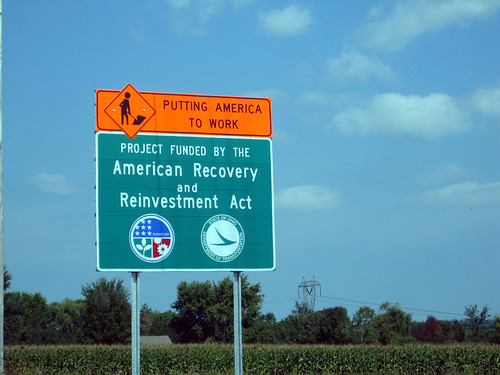While driving down I-26 to Asheville North Carolina last weekend, I noticed a sign that said “Project funded by the American Recovery and Reinvestment Act.” This was passed in 2009 under the Obama administration as a way to create jobs and promote investment and consumer spending during the recession. The measures of ARRA are worth about $787 billion.
The road sign got me thinking about acts that were passed as part of the New Deal: The Works Progress Administration (WPA) and The Civilian Conservation Corps (CCC). The WPA was created by President Roosevelt in 1935. Expenditures from 36-39 totaled nearly $7 billion. As a side note, my grandfather use to refer to the WPA as “We piddle around” for their lack of work.
The CCC was a public work relief program for unemployed men age 18-24 to provide development of natural resources in rural areas from 1933 to 1942.
In North Carolina, both the WPA and CCC helped build the Blue Ridge Parkway:
On June 30, 1936, Congress formally authorized the project as the "Blue Ridge Parkway" and placed it under the jurisdiction of the National Park Service. Some work was carried out by various New Deal public works agencies. The Works Progress Administration did some roadway construction. Crews from the Emergency Relief Administration carried out landscape work and development of parkway recreation areas. Personnel from four Civilian Conservation Corps camps worked on roadside cleanup, roadside plantings, grading slopes, and improving adjacent fields and forest lands. During World War II, the CCC crews were replaced by conscientious objectors in the Civilian Public Service program.
What does this have to do with technology?
The CCC and WPA were good ideas in the 1930’s, but there are new and greater demands that need to be met during our current recession. Government spending is at an all time high while red tape and bloat hinder a system that our founding fathers helped establish.
One of the main problems facing the government is a lack of innovation and creation with technology.
It’s time that we take the next step and create new agencies that will help bring us into the next era of a public and open government.
Large strides could be made by putting people to work in the technology sector of government. Designers, developers, community activist could all work in stride to help make how the government spends your money and help hold your elected officials accountable.
What could these jobs produce?
Designers across America for example could help redesign websites such as the South Carolina Governors Mansion website.
These jobs could help create databases of information that are publicly accessible by all. A good start would be to build a system for Roll Call voting as outlined in the South Carolina Policy Council’s 2009 transparency report. The US Senate has an XML feed of their votes available, a key piece of legislation that was championed by S.C. Senator Jim DeMint. Politico goes further into the pro’s and con’s of this.
Sites like scvotes should have API’s that work with counties GIS departments to report voting results for precints statewide in realtime on election night.
Any state ran or supported website should also make their analytics avaiable under FOIA laws. This could help determine the sites actually impact to cost ratio.
Copyright laws should also be updated and any text and photograph make publicly available. On the South Carolina Flim website for example, in the footer the following information appears:
Photographs and art on this website and any downloadable publications are copyrighted and cannot be reproduced without the written permission of the photographer and/or the South Carolina Film Commission. © 2010 by the South Carolina Film Commission, a division of SC Parks, Recreation and Tourism. All rights reserved.
All information on any taxpayer supported website needs to be licensed through a Creative Commons license. Government entities should also use open platforms such as drupal, django and share their code using Github.
SCPC also supports the idea of an online check registery. [PDF] After submitting FOIA’s to 85 district counties, 12 counties quoted an expense of more than $10,000 to complete the request.
A technological workforce reinvestment could help solve these problems by working with those 85 districts to move their financial records online using open linked data.
There are five stars to linked data: 1. make your stuff available on the web. (whatever format.) 2. make it avaiable as stuctured data (excel instead of pdf.) 3. use non-proprietary format ( csv, tab delimited instead of excel.) 4. Use urls to identify things, so that people can point to it. 5. link your data to other people’s data to provide context.
If you think about it, it’s a pretty simple idea. Why can’t citizens log in to one website and see a single view of their account with a city or state. (water, sewer, real estate, auto excise tax, registration, etc.)
All of this requires a massive amount of imagination and innovation, but it has to start from the ground up. People need to learn that they have just as much control of what happens in government as the people they elect. The media does a good job of informing what’s happening in government, but they miss a great opportunity when it comes to educating people on how to make changes.
In conclusion, it’s time to take a serious look at the types of projects we’re funding with ARRA and look for ways to promote real change through a digital workforce reinvestment.